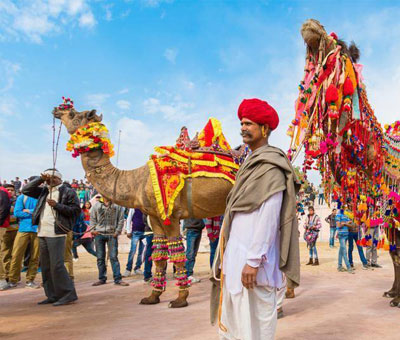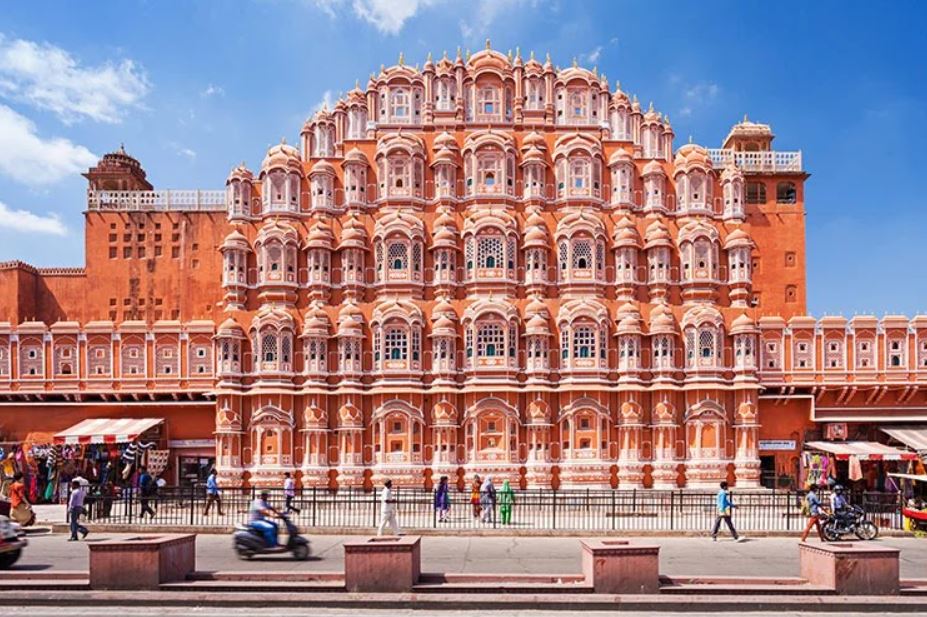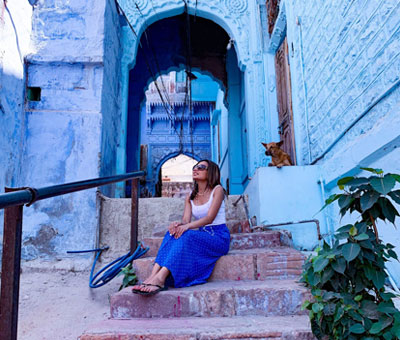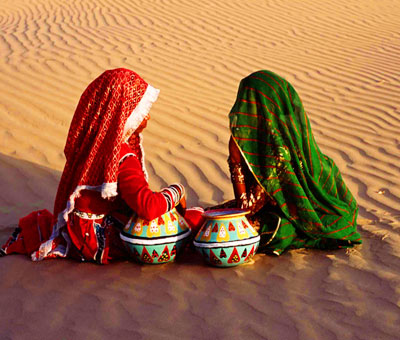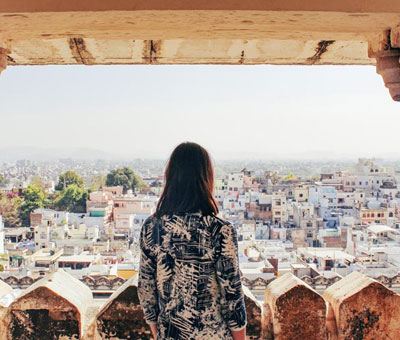Information on Arts and Crafts of Rajasthan
When it comes to sheer variety, beauty and brilliance, the handicrafts of Rajasthan are hard to beat. From elegant Meenakari work to beautiful block prints; from chunky silver jewellery to camel leather jootis, this state’s craftsmen (and women!) produce a mind-boggling array of goods that make for stunning souvenirs.

Art and Craft of Rajasthan
When you undertake Rajasthan Tour Packages, arts and crafts of Rajasthan look out for these:
Rajasthan Tour Packages
Pricing and Itinerary
Textiles in Rajasthan

Textiles in Rajasthan
Rajasthan is known for its excellent cotton fabric, and the variety of forms the cloth is available in is truly amazing. The towns of Sanganer and Bagru (both near Jaipur) produce the highly popular block printed cloth, which is created, usually in floral patterns, using vegetable dyes. Tie-and-dye fabric, known locally as bandhej or bandhini, is as popular as block prints and uses an age-old technique based on tying bits of cloth with dye-resistant thread before the cloth is dyed, so that the resultant fabric is a beautiful combination of dyed and undyed portions. Bandhej comes in different styles, such as ekdali, mothda, shikari and lehariya. Amongst the best palces to buy bandhej are Sikar, Jodhpur, Jaipur, Barmer, Udaipur and Pali. Other popular fabrics and related items include appliqué (usually made in the form of wall hangings or bedspreads, on which bits of coloured cloth are sewn into a pattern, often with supporting mirror work and embroidery; Barmer appliqué is particularly famous); beadwork, patchwork, mirrorwork and lightweight Jaipuri quilts, which are filled with lambswool.
Rajasthani Jewellery

Rajasthani Jewellery
Rajasthan’s people- both women as well as men — wear a lot of jewellery, and the production of jewellery, in silver, gold and precious stones, ranks as a major craft in the state. Chunky silver jewellery, in the form of earrings, necklaces, anklets and armlets is highly popular in rural Rajasthan, and is sometimes embellished with bits of coloured glass. On a classier level are the finely crafted meenakari and kundan work perfected by jewellers in Rajasthan’s larger cities. Meenakari, a specialty of Jaipur, Alwar, Nathdwara and Pratapgarh, takes its inspiration from Mughal styles of jewellery and is based on enamelled silver or gold, which is then inlaid with semi-precious or precious stones. Kundan, on the other hand, is an art unique to Rajasthan, in which an item (usually of gold) is first crafted, then hollowed out in places which are later filled with enamel before being studded with gemstones.
A form of jewellery which nearly died out in the past century, but has recently seen a revival is that of thewa jewellery, which involves the fusing of a thin sheet of gold onto handmade molten coloured glass. The effect is stunning, and extremely glamorous.
Woodwork

Woodwork in Rajasthan
The desert may not produce too much wood, but what there is – along with wood imported from other parts of India – is beautifully worked by local craftsmen into excellent statues, furniture and other objets d’art. Amongst the most popular expressions of Rajasthan’s woodwork are its furniture – the exquisitely carved furniture of Barmer and Jodhpur; the brightly-painted screens and doors of Kishangarh and Jodhpur; latticework, wood inlaid with brass; lacquered wood and more. Furniture too comes in distinctly Rajasthani styles – low chowkis, ornate chairs and tables, screens and bajots (low tables). Other than furniture, intricately carved statues of deities, jewellery boxes, and painted wooden puppets are also produced in Rajasthan.
Stoneware

Stoneware work in Rajasthan
Rajasthan is famous for its stone: whether it’s the lovely golden-beige sandstone of the desert, the famous greenish-blue or brown limestone known as Kota stone; or the stunning white marble from Makrana. Marble, slate, sandstone, limestone and quartzite are to be founded all over Rajasthan, and the state’s artisans do some splendid work on it – as can be seen from the beautifully carved havelis and palaces all across the state.
Pottery in Rajasthan
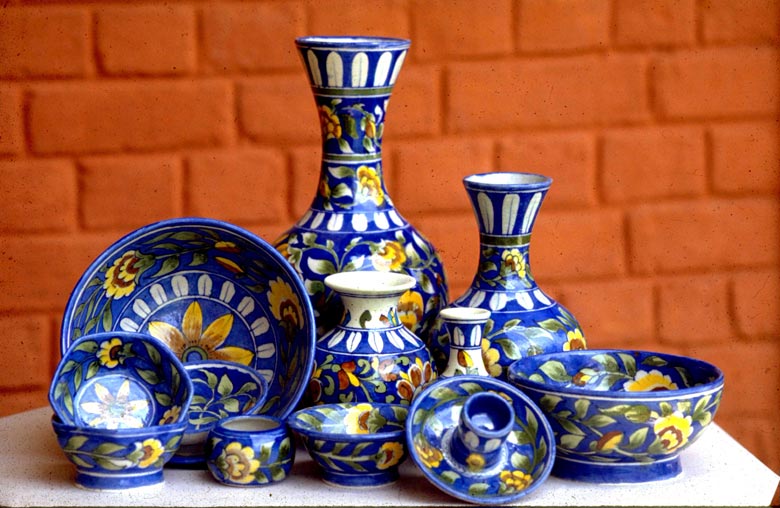
Pottery in Rajasthan
Although it is a bit difficult to pack and take away – due to the chances of breaking – Rajasthan’s fascinating range of pottery and earthenware is worth looking over. Different parts of the state have their own distinct styles of pottery-Alwar, for instance, is famous for its thin earthenware known as kagzi (paper) pottery; the village of Mollela (near Udaipur) is renowned for its terracotta ware, especially its fine reliefs of deities such as Ganesh; while Jaipur, the capital, is famed for its blue pottery. A fragile piece of pottery, Jaipur blue is made of so-called ‘Egyptian paste’, which is a self-glazing clay used to produce items that are wood-fired at low temperatures. The resultant items – vases, ashtrays, coasters, bowls, etc- are all painted in a delicate (usually floral) patterns of a distinctive blue and white. Very different from Jaipur blue, is the pottery of Bikaner, which is decorated with lac and gilt.
Leather Ware in Rajasthan
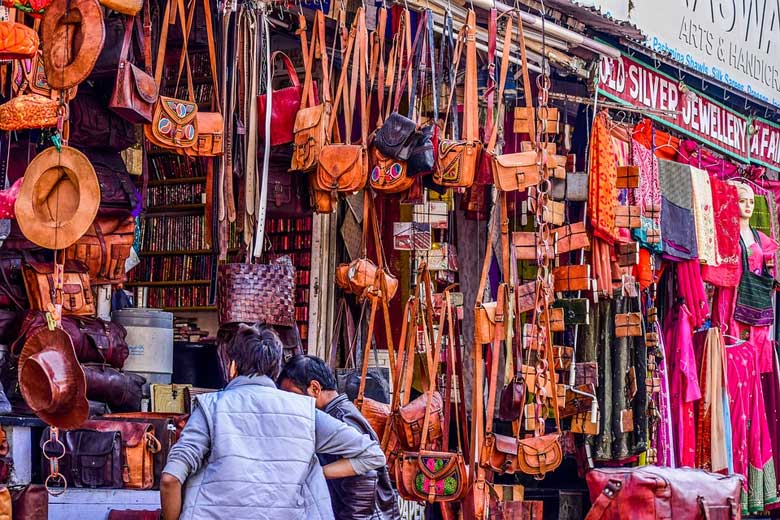
Leather Ware in Rajasthan
Rajasthan’s favourite animal – the camel-provides nearly all the raw material for the vast quantities of leatherware crafted in the state. Camel leather is used to produce everything from jootis and mojris (types of slip-on shoes) and lampshades to musical instruments and bags. For avid shoppers looking out for the perfect souvenir of the Thar Desert, a camel leather article makes for the perfect buy! Items one should keep an eye out for include embroidered jootis and mojris (especially in Jodhpur, Jaisalmer, Jaipur and Barmer); shields, vases and lampshades (in Bikaner); and collapsible chairs made of camel leather which is embellished with embroidery — a specialty of the village of Tilonia, near Ajmer. In addition to these, a vast number of bags, wallets, belts and headgear are available in all of Rajasthan’s cities.
Paintings

Paintings of Rajasthan
A range of different art styles enrich Rajasthan’s cultural heritage, and visitors can both, see as well as purchase a range of paintings, wall hangings and the like. Some local styles of painting- such as the exquisite murals which decorate havelis all across Rajasthan (and especially in the Shekhavati area near Jaipur, plus Bundi and Kota), or the elaborate line drawings that spread across the exteriors of entire huts in villages-are not portable, but Rajasthani artisans do produce a lot of exquisite items that are excellent buys for tourists. Among these are the Bani Thani paintings of Kishangarh, with their exaggerated features; the picchwai cloth paintings of Nathdwara; and the phad scroll paintings used by wandering minstrels.
Other important handicrafts in Rajasthan include carpets and dhurries (rugs) from Tonk, Jaipur and Bikaner; cloth puppets (locally called Veathputlis’); bonework and brassware.
What Makes Rajasthan Crafts Unique
Rich history and cultural influences:
Rajasthan’s history is a tapestry woven by various dynasties, each leaving its mark on artistic styles. Mughal emperors introduced Islamic motifs, while Rajput royalty nurtured intricate designs and a love for precious stones. This fusion of influences manifests in the vibrant colors, intricate patterns, and diverse techniques employed by Rajasthani artisans.
Locally sourced materials and age-old techniques:
Rajasthan’s crafts are deeply rooted in tradition. Artisans use locally available materials like marble, wood, brass, and textiles, transforming them into stunning pieces. Techniques passed down through generations ensure the authenticity and exquisite detailing of each craft. From the meticulous inlay work of Meenakari to the intricate block printing on textiles, these crafts showcase the enduring legacy of Rajasthani craftsmanship.
Vivid Colors and Bold Designs:
Rajasthan is known as the “Land of Kings,” and its crafts reflect this royal heritage. Bold colors like red, gold, and blue dominate, reflecting the grandeur and vibrancy of the region. Geometric and floral patterns are widely used, often depicting scenes from mythology, nature, or royalty. This distinct aesthetic sets Rajasthani crafts apart, making them instantly recognizable.
Uniqueness across regions:
Rajasthan boasts immense diversity. Each region within the state has its own specialty crafts. Jaipur is famous for its blue pottery, Jodhpur for its hand-embroidered textiles, and Barmer for its intricately carved wooden furniture. Exploring these regional specialties allows you to appreciate the artistic richness and heritage spread across Rajasthan.
For more information on Arts and Crafts of Rajasthan contact Swan Tours, one of the leading Travel Agents In India, established in 1995.


